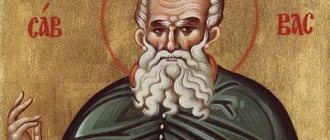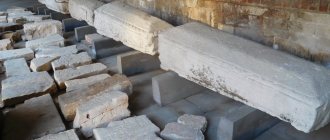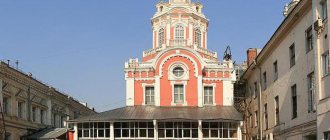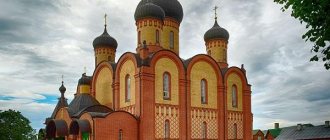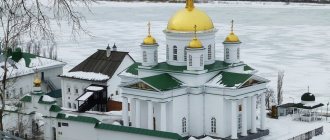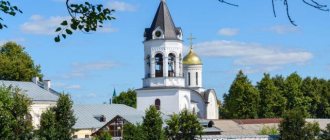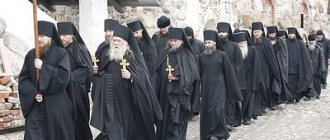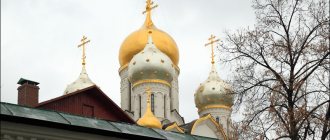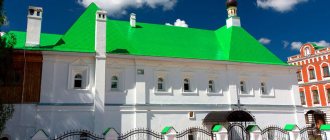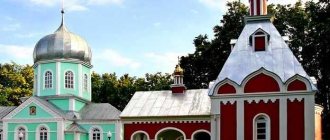Mir
Russia Moscow region Zvenigorod Savvino-Storozhevsky Monastery Map loading in progress...
{"format":"leaflet","minzoom":false,"maxzoom":false,"limit":50,"offset":0,"link":"all","sort":[""], "order":[],"headers":"show","mainlabel":"","intro":"","outro":"","searchlabel":"\u2026 \u0441\u043b\u0435\ u0434\u0443\u044e\u0449\u0438\u0435 \u0440\u0435\u0437\u0443\u043b\u044c\u0442\u0430\u0442\u044b","default":"","import-annotation":false,"width ":"auto","height":"350px","centre":{"text":"","title":"""link":"""lat":55.728566000000000713043846189975738525390625,"lon": 36.81674100000000038335201679728925228118896484375,"icon":""},"title":"","label":"","icon":"","lines":[],"polygons":[],"circles":[ ],"rectangles":[],"copycoords":false,"static":false,"zoom":8,"defzoom":14,"layers":["OpenStreetMap"],"image layers":[] ,"overlays":[],"resizable":false,"fullscreen":true,"scrollwheelzoom":true,"cluster":false,"clustermaxzoom":9,"clusterzoomonclick":true,"clustermaxradius":80, "clusterspiderfy":true,"geojson":"","clicktarget":"","showtitle":true,"hidenamespace":false,"template":"","userparam":"","activeicon": "","pagelabel":false,"ajaxcoordproperty":"","ajaxquery":"","locations":[{"text":"\u003Cb\u003E\u003Ca href=\"/palomnik/%D0% A1%D0%B0%D0%B2%D0%B2%D0%B8%D0%BD%D0%BE-%D0%A1%D1%82%D0%BE%D1%80%D0%BE%D0%B6 %D0%B5%D0%B2%D1%81%D0%BA%D0%B8%D0%B9_%D0%BC%D0%BE%D0%BD%D0%B0%D1%81%D1%82%D1 %8B%D1%80%D1%8C\" title=\"\u0421\u0430\u0432\u0432\u0438\u043d\u043e-\u0421\u0442\u043e\u0440\u043e\u0436\u0435\u0432\u0441\ u043a\u0438\u0439 \u043c\u043e\u043d\u0430\u0441\u0442\u044b\u0440\u044c\»\u003E\u0421\u0430\u0432\u0432\u0438\u043d\u043e-\ u0421\u0442\u043e\u0440 \u043e\u0436\u0435\u0432\u0441\u043a\u0438\u0439 \u043c\u043e\u043d\u0430\u0441\u0442\u044b\u0440\u044c\u003C/a\u003E\u003C /b\u003E","title ":"\u0421\u0430\u0432\u0432\u0438\u043d\u043e-\u0421\u0442\u043e\u0440\u043e\u0436\u0435\u0432\u0441\u043a\u0438\u0439 \u04 3c\u043e\u043d\u0430 \u0441\u0442\u044b\u0440\u044c","link":"","lat":55.728566000000000713043846189975738525390625,"lon":36.81674100000000038335201679728 925228118896484375,"icon":""}],,"imageLayers":[]}
55.729037; 36.816392
Russia, Moscow region, Odintsovo urban district, Zvenigorod, Ratekhinskoe highway, 9
Zvenigorod, Moscow region
Russia
Telephone:
(reception room of the governor); 8(903)274-01-21 (pilgrimage department), 8(963)640-37-00 (hotel).
Email:
; and (hotel).
Savvino-Storozhevsky Monastery
- Orthodox monastery of the Moscow diocese. Founded at the end of the 14th century, it is located on Mount Storozhi at the confluence of the Storozhka River with the Moscow River, two kilometers west of the city of Zvenigorod, Moscow Region.
Some historians claim that Tsar Alexei Mikhailovich gave the Savvino-Storozhevsky Monastery the status of the first monastery in Russia (in terms of importance and number), and only then did the Kiev-Pechersk and Trinity-Sergius monasteries receive the same status.
History[edit]
The monastery was founded in 1398 by the monk Savva, a disciple of St. Sergius of Radonezh, at the request and with the support of the Zvenigorod prince Yuri Dimitrievich. At first, a wooden church was built in the name of the Nativity of the Blessed Virgin Mary. It was located on the high mountain Storozhi, in view of the Moscow River - the main transport route to the west from Moscow at that time, at the mouth of the Rozvadni river, later called Storozhka. For privacy, Savva dug a cave in which he spent time in prayer. At first, the area of the monastery was small, but over time the number of monks grew, and the territory of the monastery increased significantly.
From the very foundation of the Savvino-Storozhevsky Monastery, Prince Yuri Dmitrievich took care of it, trying to turn it into his court monastery. Already in the first years of its existence at the beginning of the 15th century. (1402) the monastery received from the Zvenigorod prince extensive possessions in the immediate vicinity of the city: the villages of Belgino, Dubatsino and Ust-Rozvadnya with villages adjacent to them, as well as huge forests in the south of the City camp (the village of Ust-Rozvadnya on the other side of Rozvadnya later became a sub-monastery and began to be called Savvinskaya Sloboda).
In the XV-XVII centuries, the Savvino-Storozhevsky Monastery played the role of a military outpost of the Moscow Principality in the west. The monastery was a favorite place of prayer for many Russian tsars. In particular, Ivan IV the Terrible and his wife Anastasia Romanovna, as well as their son Feodor Ioannovich, came here. Under Tsar Alexei Mikhailovich, the monastery became a country royal residence. The palace of the empress and the royal chambers were erected here. At the same time, the monastery was surrounded by stone walls. The temples of the monastery were painted by icon painters from the Armory Chamber of the Moscow Kremlin. Archimandrite Nikanor (1654-1658) subsequently became the archimandrite of the Solovetsky Monastery, where he led the Solovetsky uprising in defense of the Old Faith.
The Zvenigorodsky tract was laid from Moscow to the Savvino-Storozhevsky Monastery, which was also known as the Tsar’s Road or the Road of God’s Chosen Kings; all Russian rulers: grand dukes, tsars and emperors made obligatory pilgrimages to the monastery to the relics of Savva Storozhevsky more than once. In the first half of the 20th century, this road was called Zvenigorodskoe Highway, but now it is better known as Rublevo-Uspenskoe Highway or simply Rublyovka.
During the Patriotic War of 1812, the Moscow vicar Bishop Augustin (Vinogradsky) went from the Savvino-Storozhevsky Monastery to pray for the Moscow militia. Russian shrines were taken out of the monastery - the Vladimir and Iveron icons of the Mother of God - for public prayer for the protection of the Russian land. The monastery, occupied by the French, was not plundered: according to legend, the Monk Savva appeared to the French commander Eugene Beauharnais and ordered not to touch the monastery.
In 1917, the future martyr Dimitri (Dobroserdov) was appointed rector of the monastery. In May 1918, Konstantin Ivanovich Makarov arrived here with the mandate of food commissar. His detachment requisitioned bread from the Savvino-Storozhevsky Monastery, and at the same time tried to open the shrine containing the relics of St. Savva Storozhevsky - which became the reason for the “Zvenigorod rebellion”. Participants in the rebellion killed Makarov and two other communists, but an armed detachment from Dedovsk that soon arrived suppressed the uprising... In mid-1919, the monastery was closed. In 1941, during the evacuation, the unique 35-ton Great Annunciation Bell (depicted on the coat of arms of Zvenigorod) was destroyed, the ringing of which, according to eyewitnesses, reached Moscow (at the beginning of the 21st century, another, equally massive one was installed to replace this bell). In 1986, the wooden hipped roof of one of the monastery towers burned down.
On February 9, 1995, an agreement was signed between the Administration of the Moscow Region and the Moscow Patriarchate on the joint use of part of the monastery buildings by the Zvenigorod Historical, Architectural and Art Museum and the reviving monastery, and the monastery itself received stauropegial status.
Rev. Savva Storozhevsky
The history of the Savvino-Storozhevsky Monastery is inextricably linked with the fate of its founder, the Zvenigorod wonderworker Savva Storozhevsky, a student of St. Sergius of Radonezh. He was born during the reign of Ivan Kalita, around 1327. It is also known that Savva lived part of his life in the Trinity Monastery with St. Sergius, after whose death in 1392 Savva became abbot of the Trinity Monastery. After 6 years, the monk leaves the post of abbot and, at the request of his spiritual child, Prince Yuri Dmitrievich, the youngest son of Dmitry Donskoy, moves to Zvenigorod. In the Life of the Saint it is written: “This Christ-loving prince begs the venerable elder even more so that he would never be separated from him, but would remain with him, and founded a monastery in his fatherland near Zvenigorod, where there is a place called Storozhi. Savva, zealous in obedience, seeing the prince’s spiritual desire, did not refuse this, but placed everything on Almighty God, loving the work and went to the named place. And like a heavenly paradise planted with fragrant flowers, he found it.”
Current state[edit]
Today there are 50 inhabitants in the monastery. Over the past years, the 17th-century iconostasis has been restored and the frescoes have been restored.
In August 1998, the 600th anniversary was celebrated at the Savvino-Storozhevsky Monastery. His Holiness Patriarch Alexy II, after the Liturgy at the Moscow St. Daniel Monastery, solemnly transported the relics of the Monk Savva, the founder of the monastery, to Zvenigorod. In 2007, a monument to St. Savva was unveiled.
The monastery prepares the legendary kvass, infused with raisins (giving additional “wine” fermentation). It is planned to open a Museum of Church Wine at the monastery (in a special building outside the main territory).
Monastery in the twentieth century
After 1917, the Zvenigorod monastery was closed. In 1918, as a result of the actions of local authorities, part of the monastery’s property was requisitioned, and an armed conflict occurred, resulting in casualties. The abbot of the monastery, clergy and laity who opposed the blasphemous opening of the relics of St. Savva were condemned. The relics were confiscated, and the monastery ceased to exist.
During the Soviet years, the monastery housed various institutions: military units, a sanatorium, and a museum. Over the years, all the local icons, the precious decoration of the lower tier of the iconostasis and the Royal Doors were lost in the Cathedral of the Nativity of the Virgin Mary, but the upper rows of the iconostasis were practically not damaged.
In 1995, the monastery was revived. In 1998, His Holiness Patriarch Alexy II, during the celebration of the 600th anniversary of the monastery, solemnly returned the relics of St. Savva to the Cathedral of the Nativity of the Virgin Mary, where they are kept today. The Restoration Research Institute carried out work to save the most ancient paintings of the cathedral.
Along with the existing churches of the current monastery, expositions and exhibitions of the Zvenigorod Historical, Architectural and Art Museum are located on the territory. In the Tsarina's Chambers, the interiors of the boyars' chambers have been restored; visitors can see furniture, dishes, fabrics, women's jewelry from the 17th century and recreated tiled stoves. Today, the monastery has an orphanage, theological courses are held, and a library has been opened, the funds of which amount to 6.5 thousand volumes.
Buildings and structures[edit]
Cathedral of the Nativity of the Virgin Mary, early 15th century
Temples[edit]
- Nativity of the Virgin Mary Cathedral (the traditional date of construction - 1405 - is disputed), later the Savvinsky (southern) chapel, a double-sided porch and a sacristy were added to the cathedral, the kokoshniks were recreated by Soviet restorers;
- The Gate Church of the Life-Giving Trinity was built by I.M. Sharutin in 1650;
- Church of St. Sergius of Radonezh in the bell tower;
- Church of St. Alexis, the man of God;
- Refectory Church, Temple of the Transfiguration of the Lord (built in 1695 by order of Princess Sophia).
Other buildings[edit]
- The refectory (1652-1654) is a four-story building, which Pavel of Aleppo described with admiration. The old refectory and the Holy Gate, found during excavations, were built in the 16th century.
Royal Chambers
- The Tsarina's Chambers (1652-1654). The palace was built for Tsarina Maria Ilyinichna Miloslavskaya, the first wife of Tsar Alexei Mikhailovich. Until 1828, this one-story building with a basement had a second wooden floor. The building is divided into front and utility halves. The front half consists of three parts with separate entrances: the central part is for the queen, the side parts are for the retinue. In the utility half, a suite of rooms runs through the entire building.
- The palace of Tsar Alexei Mikhailovich was built in three stages. In 1652-1654. The northern part of the palace was built. In 1674-1676. The palace became a one-story building on a basement of seven cages with separate entrances about one hundred meters long. The front central part was occupied by the king's chambers, in the northern part there were kitchen premises, the remaining cells were intended for the royal family and retinue. The four cages had a wooden second floor, where narrow staircases inside the walls led. In 1686-1687 Under Princess Sophia, the roof and planked towers were dismantled and a second floor was built with a suite of rooms along the entire length of the building. Instead of internal staircases, external stone porches were built to the second floor. The palace was badly damaged in the fire of 1742.
- The brethren's buildings (mid-17th century), the habitat of the monks, were repeatedly completed and rebuilt.
- Residential building of theological schools designed by D. F. Borisov (1820s) on the site of the Treasury building.
- The belfry has a four-tier structure, which is crowned with four stone tents with domes.
Towers[edit]
The fortress was built according to the royal decree under the leadership of N. M. Boborykin and A. Shakhov.
In the monastery, I.M. Sharutin, who also built the walls of the Trinity Kalyazin Monastery, built seven towers in 1650-1654, six have survived to this day.
- Red (above the Holy Gate)
- Zhitnaya
- Vodovzvodnaya
- Usovaya
- Sick leave (not preserved)
The second stage of construction of the monastery in the mid-17th–19th centuries
In 1650, the second significant period in the history of the construction of the monastery began - Tsar Alexei Mikhailovich issued a decree on the creation of a new monastery ensemble on Mount Storozhi. It was then that the monastery acquired an appearance that has largely been preserved to this day. On January 19, 1652, with the participation of the king, the relics of the abbot were found. The king chose the monastery as his residence. The palace of the empress and the royal chambers were erected here. The Tsarina's Chambers were built especially for Tsarina Maria Ilyinichna.
Alexey Mikhailovich began to call the monastery Lavra and equated it with the Trinity-Sergius Monastery.
The necessary restoration work was carried out in the Nativity Cathedral, galleries were added, in one of which the Tsar’s chapel was located. The walls of the temple were re-painted by 29 royal icon painters, led by Stepan Ryazants and Vasily Ilyin. Fragments of the earliest paintings of the temple, which date back to the 15th century and belong to the masters of the circle of St. Andrei Rublev, have survived to this day.
In 1650–1656, the main buildings and fortress walls with seven towers were built, of which six remain. Temples were built: the gateway in the name of St. Sergius of Radonezh, later reconsecrated in honor of the Life-Giving Trinity; Preobrazhensky, as well as the belfry and the Refectory Chamber, the Tsar's Palace and the Tsarina's Chambers, the Brotherhood and Cell buildings.
In the 18th century, the monastery lost its position and a significant part of its land holdings. The sovereigns continued to visit him: Empress Elizaveta Petrovna, as well as Empress Catherine II. In 1839, Emperor Nicholas I visited him, and later Emperor Alexander II came to venerate the relics of St. Savva.
Patronal holidays[edit]
Nativity of the Blessed Virgin Mary
- September 21
The following four holidays are associated with the memory of St. Savva of Storozhevsky:
December 16 is the day of the saint’s righteous death in 1407;
February 1 - discovery of holy relics in 1652;
July 30 - transfer of holy relics and placing them under a new canopy in 1847;
August 23 - the second discovery and transfer of holy relics from the Moscow St. Danilov Monastery to the Savino-Storozhevsky Monastery in 1998.
History of the monastery
Construction of the monastery began in the late 1390s with the construction of the Church of the Nativity of the Blessed Virgin Mary. It was wooden and short-lived. Savva himself lived outside the monastery in a small cave, indulging in prayer and fasting. But as the brethren grew, so did the territory of the monastery.
Now it is a large stone monastery with the status of a Lavra . It is interesting that the Savvino-Storozhevsky Monastery in Zvenigorod acquired this special position even earlier than the Kiev-Pechersk and Trinity-Sergius monasteries. It was given to the Storozhevsky Monastery in the middle of the 17th century by Tsar Alexei Mikhailovich.
The history of the monastery is a combination of military and spiritual feats. Until the 17th century, Zvenigorod was a border city, and the Savvino-Storozhevsky Monastery, which was a powerful fortress, was an outpost on the western border of the country.
In 1812, there was a French garrison in the monastery. However, the occupiers did not touch the shrine, and the monastery was not damaged. The reason for this incredible fact is considered, according to legend, that Savva Storozhevsky himself appeared to Eugene Beauharnais, Napoleon’s stepson and one of the commanders of his army, with a request not to touch the monastery. And the impressionable French commander listened to our saint.
The twentieth century turned out to be less merciful for the Storozhevsky monastery. In 1919, the monastery was abolished, and in the fall of 1941 it suffered greatly, since the front line passed nearby and there were battles for Moscow.
During the years of Soviet power, various institutions were located in the monastery: an orphanage, a military sanatorium, a prison, a museum. Only in 1995, the Savvino-Storozhevsky Monastery was returned to the church, and now an Orthodox monastery is located here again.
How to get there[edit]
Address:
Moscow region, Zvenigorod (Odintsovo district), Gorodok, 5.
Directions:
You can get to Zvenigorod by bus from the Kuntsevo metro station or by train from the Belorussky railway station. Zvenigorod station is the final station of the side branch; trains go there infrequently (on average once every 1.5 hours), so when planning your trip, find out the schedule. The station is located outside of Zvenigorod; you still need to get to the city or its environs. Buses run from the station, the departure of which is synchronized with the train schedule. Routes No. 23 and 51 follow to the monastery.
Telephone:
(reception room of the governor); 8(903)274-01-21 (pilgrimage department), 8(963)640-37-00 (hotel).
Email:
; and (hotel).
On the way to the temple
The Savvino-Storozhevsky Monastery in Zvenigorod is one of the rare and valuable cultural and historical sites.
Not a single person who comes to this city can ignore it. And if we look at history, many Russian tsars loved this monastery very much. Ivan the Terrible came here with his first wife Anastasia Romanova, and their son Tsar Fyodor Ioannovich. Tsar Alexei Mikhailovich visited here very often. Several country residences were built for him near Moscow.
But since this monarch was particularly pious, he often preferred to spend his “summer holidays” in the Storozhevsky Monastery.
By his order, a road was built to the monastery - the Zvenigorodsky tract, which was also called the “Royal Road”. Now it has not lost its privileged status, since it is called Rublevo-Uspenskoe Highway.
Now you can get to the Savvo-Storozhevsky Monastery along the Mozhaisk or Minsk highway to Zvenigorod. If the choice is made in favor of public transport, you will have to travel from the Belorussky train station by train or bus to Zvenigorod.
How does it all happen?
Everyday and unnoticed. So you walk the dog, as usual, in the evening, come home, feed it and, if the dog lives on the street, forget about it until the morning. But this evening you notice strange sounds - objects rattling on the veranda, something falling and then rhythmic thuds on the floor. When you look out, you can see your beloved dog lying on his back and beating his head on the floor in convulsions. The thought (and the correct one) is poisoning? Yes, it’s an ass, but this is life and the dog’s countdown is already ticking. You go to the computer (the clock says 22:00, the nearest veterinarian in Posad is already closed) and open the Internet in search of information on what and how to save. You type in “dog poisoning” and the second link goes to the forum, quickly read the information and understand - yes, there is useful information and an important sequence of actions. You send it to print, get dressed and at the same time call two or three people who, in your opinion, may know exactly more than you.
Of the three, you get feedback from one, the paper with instructions in your pocket, and you are on the street. There is no dog, but here it appears, wiping the corner of the house with its back on crooked legs, foaming at the mouth, growling and baring its teeth and running past deeper into the plot.
You are in the car, you are in the duty pharmacy A5 (on Moskovskaya in the Svyaznoy building), you are second in line and read three sheets of paper, and when it’s your turn, you dictate in a row everything that comes across from the text, plus you add saline solution, an IV and syringes. You are driving home, it’s -16 degrees and cold outside, there is no dog. A flashlight in your hand, in the second bag from the pharmacy, and you yourself are on your hands and knees in the underground floor of the veranda - no, to the barn - no, in the underground floor of a house under construction (it’s easy for a dog to get into the underground here, but not for you) - again no. This doesn’t happen, let’s start again in a circle.
The underfloor of the veranda - now there is a lying back, still breathing. I crawl on my belly towards the dog - but then the dog scoops it up and runs away growling into the darkness. Damn, how do you catch a growling dog in a fit!? Bang, a thud on the fence and legs twitching out of the snowdrift - CHANCE! Running with a bag of a bunch of everything and kneeling on the dog - the first thing on the list is B6, 5 mg intramuscularly (that’s how it was deposited). You split the ampoule, fill it with a syringe (all in the cold) and into the dog where people have a shoulder (in general, it’s better to go into the thigh - this is the shoulder on the hind legs).
Then, suddenly, out of the darkness, an alarmed female help appears in a down jacket over her naked body, she is handed a package from the pharmacy, and the animal, twitching in convulsions, drags onto the veranda - it is impossible to go into the house, the children have not yet fallen asleep. While you’re dragging it, you start to remember whether you injected the right dosage - on the box there is a large number 50, which means 50 ml in one ampoule... but somehow the ampoule is too small for 50 ml (since 50 ml is a glass), I reach the veranda, my bare knees are unexpected help is placed on the dog, which in convulsions clenches its jaw so that there is a feeling that the dog is about to eat itself.
I read the box again - it’s true - 50 is the concentration, and ampoules are 1 ml. You split the ampoule and try to draw the syringe, but the liquid in the needle has frozen (you realize this on the fourth attempt to pull back the piston). A new syringe, 9 ampoules with frozen fingers (actually 8, I lost one on the way and found it in the morning, instead of liquid there was salt in it - it burned in my hands while I was walking into the house (cool) and injected to the heap, but this was in the morning), and again in left shoulder.
The cramps either subside a little, then again with renewed vigor, but you have to wait about 10 minutes. If the cramps don’t go away after 10 minutes, you need to inject magnesium, but this is already a serious matter, I wouldn’t want to. In between convulsions, the dog vomited, although I don’t remember the process, I remember the result. The cramps are over, the unexpected help with bare knees is already freaking out from the cold (you can see it in the eyes) and the whole team moves into the corridor of the house. Next on the list is an injection of cocarboxylase (I didn’t buy it, so I went to the pharmacy one more time), then a glucose drip with added vitamin C subcutaneously. Putting a catheter, especially for the first time, didn’t even occur to me (although this is always more useful and effective).
After 200 ml of 5% glucose, the dog began to get up and try to walk, but with a slightly plaguey look. She even started running around in the street, then yelling in a strange voice - the roof was clearly not in place yet. After about 10 minutes I was freezing and generally wanted to sleep and forget about it all, but the dog didn’t want to come into the house, and he didn’t want to go back to his place either, he walked around chaotically. Well, with the thought “I did everything I could” you go to sleep.
Early in the morning (the frost was just under 20 then), you take a flashlight and look for the dog in a third circle. Not anywhere. FAC. I don’t want to find a stiff corpse at all, but not finding anything is somehow closer to the option with a corpse than the other way around.
You have breakfast and go look again. The child is with you. He crawls into places where you can’t get through and sees the dog. She’s not scared, which means maybe she’s alive. You crawl into places where you wouldn’t have climbed before and theoretically shouldn’t have crawled through - a dog with narrow pupils lies, or rather tries to lie with its head raised, but it is constantly blown to the side. The dog doesn’t look good, you crawl towards it on your belly, grab it and, in a nose-to-nose position, back away, drag it home in your arms, wondering how the hell these 25 kg are heavy.
You call the veterinarian and for some reason they tell you that they start at 10! Well, yes, today is a day off (February 25), but the hours seem to be from 9 to 18 every day, but the voice on the phone is extremely stubborn (the security guard definitely answered the phone, and the clinic was open from 9 that’s for sure!). To hell with you, the dog needs another injection of cocarboxylase and glucose subcutaneously, just in time to get dressed and have a good time. The dog has come to his senses a little and is already sitting in the trunk. At the veterinarian, an anamnesis, blood tests, a catheter, three droppers of Ringer's solution and one of glucose, a couple of additional liquids in the dropper and an injection of baralgin. The dog passed out from a sleepless night and only moaned occasionally. 3 hours of IV and home.
The worst is over. Then there were three more days of drips, but they took place in a purely technical format. The dog fully returned to its life on the 5th day after poisoning.
I want and hope that you, an inanimate schmuck in the form of a man who threw an infection that my dog ate with gusto, will read this. Well, it will be a little universally honest for you to understand in detail all the consequences of your cowardly act. It would be nice if you still had a little empathy so that you could even feel all this for yourself.
Savvino-Storozhevsky Monastery
On the quiet banks of Moscow, churches crowned with crosses, the dilapidated chapters shine above the monastery walls. All around there are groves that have never been cut down in the hills, and the holy relics of the Saint have rested there for a long time.
A. S. Pushkin dedicated this poem to the Savvino-Storozhevsky Monastery
Zvenigorod. I’ve been wanting to go there for a long time, and it just happened to be a free weekend... 46 km west of Moscow in a picturesque location on a hill is the city of Zvenigorod. And 1.5 km from Zvenigorod on Storozhevaya Mountain is the Savvino-Storozhevsky Monastery. A beautiful, ancient, holy place! As with many monasteries, there is an interesting combination of different architectural styles.
Temples and chapels of the monastery:
1. Cathedral of the Nativity of the Blessed Virgin Mary (1404-1405) 2. Gate Church of the Life-Giving Trinity 3. Church of St. Sergius of Radonezh (in the belfry) 1650 4. Church of the Transfiguration (1693) 5. Chapel-gazebo (1998) 6. Chapel over the Holy Spring of St. Savva Other buildings of the monastery: 7. Northern gate 8. Streletsky chambers (XVII-XVIII centuries) 9. Refectory chamber (1652-1654) 10. Palace of Tsar Alexei Mikhailovich (XVII century) 11. Brethren buildings (2nd half of the 17th century) 12. Tsarina's chambers (XVII century) 13. Refectory with a chapel in honor of the Kazan Icon of the Mother of God (1807) 14. Monastery building 15. Treasury building (2nd half of the 17th century) 16 Red Tower (XVII century) 17. Water Tower (XVII century) 18. Usova Tower (XVII century) 19. Zhitnaya Tower (XVII century) 20. Towers and fence walls (2nd half of the XVII century. ) 21. Monument to Rev. Savva Storozhevsky (2007)
A little history
The monastery was founded in 1398 on the high bank of the Moscow River on Mount Storozhe, which was a defensive fortification of the Moscow principality. The monastery was founded by the Monk Savva, the Zvenigorod wonderworker, one of the first disciples of the Monk Sergius of Radonezh, at the request of the Zvenigorod Prince Yuri Dmitrievich, the second son of the Great Moscow Prince Dimitri Donskoy. Initially, the monastery had wooden walls (tyn).
Around 1405, the white-stone Nativity Cathedral was built, at the entrance to which the Monk Savva, canonized, was buried.
In 1650, Tsar Alexei Mikhailovich issued a decree on the construction of a new monastery ensemble on Mount Storozhe, which began the second construction period in the monastic history. Already in the spring-autumn of 1649, the necessary construction work was carried out in the Nativity Cathedral and the paintings were done anew.
In 1650–1656 the main buildings and fortress walls were built (length 760 m, height 8–9 m, thickness about 3 m) with 7 towers, of which 6 have survived to this day. Temples were built in the monastery fence: the gateway in the name of St. Sergius of Radonezh (1651 –1652), later reconsecrated in honor of the Life-Giving Trinity; Preobrazhensky (second half of the 17th century), as well as the belfry and the Refectory Chamber (1650s), the Tsar's Palace and the Tsarina's Chambers (1650s), the fraternal and cell buildings and other buildings.
In 1812, the Savvino-Storozhevsky Monastery shared the fate of many Russian monasteries, but, despite the general ruin of the monastery, the relics of St. Savva remained untouched.
In 1918, in Zvenigorod, as a result of the actions of local authorities who requisitioned part of the monastery’s property, an armed conflict occurred, resulting in casualties. The abbot of the monastery, Abbot Macarius (Popov), clergy, and laymen were convicted in the “Zvenigorod case.” In March 1919, the blasphemous opening of the relics of St. Savva caused protests from the brethren and residents of the city. Arrests followed. The relics of St. Savva were confiscated and the monastery was closed.
During Soviet times, the monastery housed various institutions: military units, a sanatorium, and a museum.
Part of the relics of St. Savva Storozhevsky was preserved in the Uspensky family. In 1985, the shrine was transferred to the Moscow St. Daniel Monastery.
In 1995, the monastery was revived. During the celebration of the 600th anniversary of the monastery in 1998, His Holiness Patriarch Alexy II solemnly transferred the relics of St. Savva to it.
Monument to St. Savva Storozhevsky.
Savva Storozhevsky - reverend of the Russian Church, founder and first abbot of the Mother of God of the Nativity (Savvino-Storozhevsky) monastery in Zvenigorod, Zvenigorod wonderworker, one of the most famous Russian saints, spiritual ascetic of Russia, “patron of kings” and “defender of Moscow”, healer, seer , “a refuge for all sinners.”
Northern gate of the monastery.
The largest building of the monastery is the four-story building of the Refectory with a glacier, a well and a dining chamber. It is characteristic that already in the 17th century glass, rather than mica, was inserted into the windows, and heating was installed in the room.
Chapel-gazebo.
The Cathedral of the Nativity of the Blessed Virgin Mary immediately attracts attention. He's great. And not so much from the outside as from the inside. It is functional, it does not have particularly rich decoration, but there is a powerful aura and an amazing spirit of the Time.
Refectory Church of the Icon of Our Lady of Kazan (yellow building) 1807
The chambers of the king and queen were impressive, but you just can’t envy how they lived in those days, especially the queen, her whole life was spent within these four walls and in the church, although who knows, maybe she lived very well... For the convenience of the queen, the chambers connected by a passage with the neighboring gate church, which became a house church. Next to the red and white Trinity Church, where the museum’s funds are now located, are the Tsarina’s Chambers - Queen Mary of Miloslavskaya. The hipped front porch is decorated with thick jug-shaped columns. The creators found a simple solution for the color scheme of the building: the red color of the brick from which it is made contrasts well with the whiteness of the carved stone. This elegant structure differs sharply from the huge, majestic, but cold royal palace located opposite.
The palace (chambers) of Tsar Alexei Mikhailovich entered the history of Russian architecture as one of the most significant monuments of civil architecture of the mid-to-late 17th century. Built in the 1650s for pilgrimages to the sovereign’s monastery. Due to the difficult terrain and the significant size of the building (the length of the façade is about 100 m), construction took several decades.
Zhitnaya Tower. The walls and towers were built in four years (1650–1654).
Angel at the top of the Zhitnaya Tower.
The monastery ensemble is completed by a four-tiered belfry with three tents and a clock tower. In 1930, the Savvino-Storozhevskaya monastery lost almost all of its bells. 11 small and 5 large bells were removed and sent for melting. There are only 2 bells left on the belfry - the large Blagovestny and the sentry bells. The Great Blagovestny was taken from the monastery in 1941. The bell weighed about 34 tons. According to the official version, when trying to remove the bell from the belfry, it fell to the ground and broke. However, there is another version, according to which the bell was blown up directly at the belfry. Be that as it may, fragments of the bell were scattered throughout the monastery - several fragments and part of the bell tongue were found.
By the way. Previously, the entrance to the monastery was in a different place, next to the Tsarina’s Chambers, through the Red Gate. The Red Tower is currently under restoration. Go down the steps and enter from there. A completely different impression. Behind the Red Gate there is a small front courtyard. From here two staircases led to the main square. The first, wide, intended for guests of honor, passed through the basement of the Trinity Church, the second, for ordinary visitors, narrower, went north of the Trinity Church. The entrance from the courtyard to the first staircase is decorated with white stone columns, decorated with rosettes and wall paintings.
We go around the walls of the monastery. I recommend going around the monastery along the path along the slope - beautiful views open up.
View from the observation deck down to the pond.
Along the paths along the slope we go down to the well of St. Sava.
Monk Sava's monastery
Not far from the Savvino-Storozhevsky Monastery is the Savvinsky monastery, in which the Monk Savva performed his feat of prayer more than 600 years ago. This place is no less a landmark of Zvenigorod than the monastery itself. I will not be mistaken if I say that many who come to the Savvino-Storozhevsky Monastery do not even suspect that there is a monastery two kilometers from it.
On the territory of the monastery there is a chapel-font over the spring of St. Sava. A wonderful bath, and most importantly, the nature around is extraordinary. The bathhouse is large, separate, everything is very nice... It’s really worth coming here. Blessed place!
A little history
According to legend, the Monk Savva often retired to a small cave, dug or discovered by him not far from the monastery, for solitude and prayer. In the 1860-1870s, a church was erected above the cave in the name of St. Savva of Storozhevsky, and next to it the ensemble of the monastery monastery was built. Initially, it was called the “dormitory department” and was a whole monastery with two churches, cells and economic services, surrounded by stone walls with turrets.
Savvinsky Monastery suffered greatly during Soviet times, many buildings were destroyed. After the war, families of military sanatorium employees lived here.
On the occasion of the 600th anniversary of the repose of the Zvenigorod Wonderworker, the saint’s cave was restored, the surviving buildings were restored, monastery life was revived, the source of St. Savva was restored, and a bathhouse was built. There is a monastery on the territory of the monastery.
The path running past the temple leads directly to a small monastery with a church in the name of St. Sava.
Near the entrance there is a cross with the inscription “In memory of the deceased brethren of the holy monastery.”
You can look behind the fence of the monastery only by climbing the stairs to the hill.
From here you have a beautiful view of the surrounding area.
It is better to buy souvenirs in the monastery, and not on the approaches to it or in the parking lot: there is more choice and it is cheaper. The store sold bread, cakes, pies, tea and coffee. I advise you to buy monastery onion bread, very tasty kvass and mead.
The monastery is “beautiful, well-kept and famous”; in recent times it has attracted a huge number of people, especially on weekends and holidays.
Summary: it’s worth a trip to relax your soul and enjoy nature.
Photos by the author
